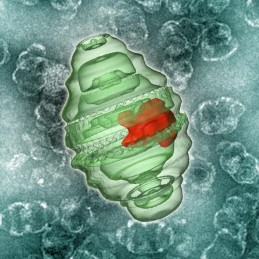Nanoscale vaults encapsulate ‘nanodisks’ for drug delivery
April 22, 2011

Single-particle electron microscope tomography reconstruction showing a fully assembled drug-loaded nanodisk (red) packaged into a vault lumen (green) as a viable method for vault-mediated drug delivery (credit: UCLA)
Researchers at UCLA have developed the ability to package drug-loaded “nanodisks” into vault nanoparticles, which are naturally occurring nanoscale capsules engineered for therapeutic drug delivery.
Vault nanoparticles are found in the cytoplasm of all mammalian cells and are one of the largest known ribonucleoprotein complexes in the sub-100-nanometer range. A vault is a barrel-shaped nanocapsule with a large, hollow interior — properties that make them ripe for engineering into a drug-delivery vehicles. The ability to encapsulate small-molecule therapeutic compounds into vaults is critical to their development for drug delivery.
With the goal of creating a vault capable of encapsulating therapeutic compounds for drug delivery, the researchers designed a strategy to package another nanoparticle, known as a nanodisk (ND), into the vault’s inner cavity, or lumen.
The recombinant vaults were engineered to encapsulate the highly insoluble and toxic hydrophobic compound all-trans retinoic acid (ATRA) using a vault-binding lipoprotein complex that forms a lipid bilayer nanodisk.
Electron microscopy and X-ray crystallography studies demonstrated that both endogenous and recombinant vaults have a thin protein shell enclosing a large internal volume of about 100,000 cubic nanometers, which could potentially hold hundreds to thousands of small-molecular-weight compounds, the researchers said.
Ref.: Leonard H. Rome et al., Vaults Engineered for Hydrophobic Drug Delivery, April 20 online edition, Small
